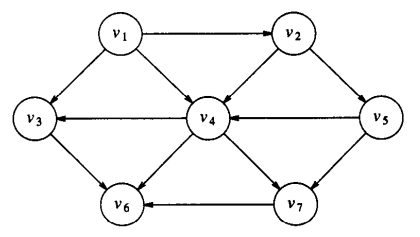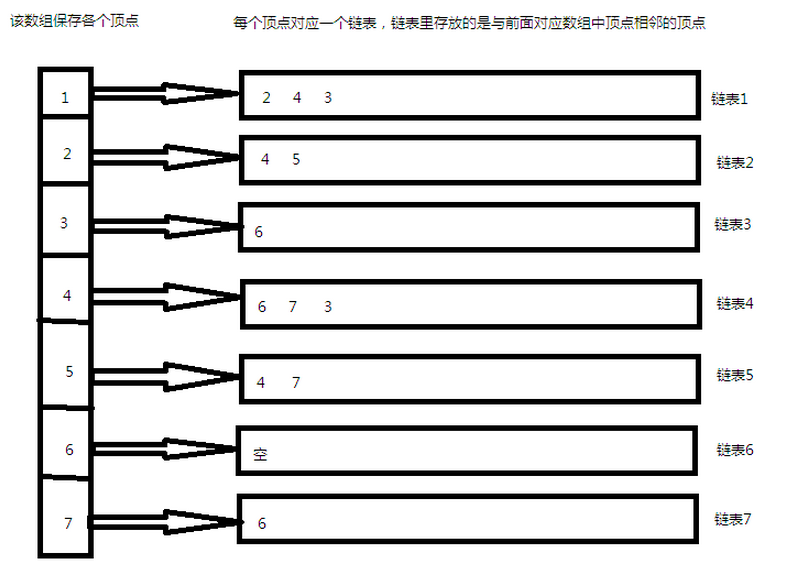拓撲排序簡介:
拓撲排序是對
有向無環圖的頂點的一種排序,它使得如果存在一條從Vi到Vj的路徑,那麼在排序中Vi在Vj的前面。
如果圖中含有回路,那麼拓撲排序是不可能的。此外,拓撲排序不必是唯一的,任何合理的排序都可以。

對於上面的無環圖:v1,v2,v5,v4,v3,v7,v6和v1,v2,v5,v4,v7,v3,v6都是合理的拓撲排序。
一個簡單的求拓撲排序的思路:
1、先找出任意一個沒有入邊的頂點
2、然後顯出該點,並將它和它鄰接的所有的邊全部刪除。
3、然後,對圖中其它部分做同樣的處理。
圖用鄰接表表示法來存儲:
參考博客:數據結構與算法——圖的鄰接表表示法類的C++實現

左邊的數組此時就有用了,用來保存每個頂點的信息,該數組中每個元素的數據結構為:
//保存每個頂點信息的數據結構
struct GraphNode{
int vertex;//當前頂點的標號
int inDegree;//當前頂點的入度
int topNum;//當前頂點的拓撲排序的順序標號
};
圖的鄰接表示法的類的接口:
/*******************************************************
* 類名稱: 鄰接表圖
********************************************************/
class Graph{
private:
int edge_num;//圖邊的個數
int vertex_num;//圖的頂點數目
list * graph_list;//鄰接表
vector nodeArr;//保存每個頂點信息的數組
public:
Graph(){}
Graph(char* graph[], int edgenum);
~Graph();
void print();
vector topoSort();//拓撲排序
private:
vector get_graph_value(char* graph[], int columns);
void addEdge(char* graph[], int columns);
};
拓撲排序成員函數:
/*************************************************
* 函數名稱:topoSort()
* 功能描述:對圖中的頂點進行拓撲排序
* 參數列表:無
* 返回結果:返回頂點拓撲排序之後的結果
*************************************************/
vector Graph::topoSort()
{
vector topoSortArr;
for(int count = 0; count < vertex_num; ++count){
//找到一個入度為0的頂點
int i;
for(i = 0; i < vertex_num; ++i){
if((nodeArr[i].inDegree == 0)&&(nodeArr[i].vertex != -1))
break;
}
if(i == vertex_num)
break;
//此時頂點i的入度為0
//刪除該點和刪除與該點相鄰的邊
//並將與頂點i相連的頂點的入度減1
nodeArr[i].inDegree = -1;
for(list::iterator it = graph_list[i].begin(); it != graph_list[i].end(); ++it){
nodeArr[(*it).vertex].inDegree--;
}
topoSortArr.push_back(i);
}
return topoSortArr;
}
測試函數:
1、讀取圖文件中的數據,圖中的數據格式為下面所示:
0,0,1,1
1,0,2,2
2,0,3,1
第1列是邊號,第2列是邊的起點,第3列是邊的終點,第4列是邊的權重。
/****************************************************************
* 函數名稱:read_file
* 功能描述: 讀取文件中的圖的數據信息
* 參數列表: buff是將文件讀取的圖信息保存到buff指向的二維數組中
* spec是文件中圖最大允許的邊的個數
* filename是要打開的圖文件
* 返回結果:無
*****************************************************************/
int read_file(char ** const buff, const unsigned int spec, const char * const filename)
{
FILE *fp = fopen(filename, "r");
if (fp == NULL)
{
printf("Fail to open file %s, %s.\n", filename, strerror(errno));
return 0;
}
printf("Open file %s OK.\n", filename);
char line[MAX_LINE_LEN + 2];
unsigned int cnt = 0;
while ((cnt < spec) && !feof(fp))
{
line[0] = 0;
fgets(line, MAX_LINE_LEN + 2, fp);
if (line[0] == 0) continue;
buff[cnt] = (char *)malloc(MAX_LINE_LEN + 2);
strncpy(buff[cnt], line, MAX_LINE_LEN + 2 - 1);
buff[cnt][4001] = 0;
cnt++;
}
fclose(fp);
printf("There are %d lines in file %s.\n", cnt, filename);
return cnt;
}
2、釋放剛才讀取的圖的信息
/****************************************************************
* 函數名稱:release_buff
* 功能描述: 釋放剛才讀取的文件中的圖的數據信息
* 參數列表: buff是指向文件讀取的圖信息
* valid_item_num是指圖中邊的個數
* 返回結果:void
*****************************************************************/
void release_buff(char ** const buff, const int valid_item_num)
{
for (int i = 0; i < valid_item_num; i++)
free(buff[i]);
}
3、主測試函數
int main(int argc, char *argv[])
{
char *topo[5000];
int edge_num;
char *demand;
int demand_num;
char *topo_file = argv[1];
edge_num = read_file(topo, 5000, topo_file);
if (edge_num == 0)
{
printf("Please input valid topo file.\n");
return -1;
}
Graph G(topo, edge_num);
G.print();
vector topoSortArr = G.topoSort();
cout << "拓撲排序的結果: ";
for(unsigned i = 0; i < topoSortArr.size(); ++i)
cout << topoSortArr[i] << " ";
cout << endl;
release_buff(topo, edge_num);
return 0;
}
圖類的源代碼:
#ifndef GRAPH_H
#define GRAPH_H
#include
#include
#include
#include
#include
#include
#include
#include
#include
#include
#include
using namespace std;
#define MAX_VERTEX_NUM 600
//保存每個頂點信息的數據結構
struct GraphNode{
int vertex;//當前頂點的標號
int inDegree;//當前頂點的入度
int topNum;//當前頂點的拓撲排序的順序標號
};
//圖節點信息
typedef struct Node{
int edge_num;//邊號
int src;//源點
int vertex;//自身
int weight;//邊的權重
}Node;
/*******************************************************
* 類名稱: 鄰接表圖
********************************************************/
class Graph{
private:
int edge_num;//圖邊的個數
int vertex_num;//圖的頂點數目
list * graph_list;//鄰接表
vector nodeArr;//保存每個頂點信息的數組
public:
Graph(){}
Graph(char* graph[], int edgenum);
~Graph();
void print();
vector topoSort();//拓撲排序
private:
vector get_graph_value(char* graph[], int columns);
void addEdge(char* graph[], int columns);
};
/*************************************************
* 函數名稱:topoSort()
* 功能描述:對圖中的頂點進行拓撲排序
* 參數列表:無
* 返回結果:返回頂點拓撲排序之後的結果
*************************************************/
vector Graph::topoSort()
{
vector topoSortArr;
for(int count = 0; count < vertex_num; ++count){
//找到一個入度為0的頂點
int i;
for(i = 0; i < vertex_num; ++i){
if((nodeArr[i].inDegree == 0)&&(nodeArr[i].vertex != -1))
break;
}
if(i == vertex_num)
break;
//此時頂點i的入度為0
//刪除該點和刪除與該點相鄰的邊
//並將與頂點i相連的頂點的入度減1
nodeArr[i].inDegree = -1;
for(list::iterator it = graph_list[i].begin(); it != graph_list[i].end(); ++it){
nodeArr[(*it).vertex].inDegree--;
}
topoSortArr.push_back(i);
}
return topoSortArr;
}
/*************************************************
* 函數名稱:print
* 功能描述:將圖的信息以鄰接表的形式輸出到標准輸出
* 參數列表:無
* 返回結果:無
*************************************************/
void Graph::print()
{
cout << "******************************************************************" << endl;
//for(int i = 0 ; i < MAX_VERTEX_NUM; ++i){
for(int i = 0 ; i < vertex_num; ++i){
if(graph_list[i].begin() != graph_list[i].end()){
cout << i << "-->";
for(list::iterator it = graph_list[i].begin(); it != graph_list[i].end(); ++it){
cout << (*it).vertex << "(邊號:" << (*it).edge_num << ",權重:" << (*it).weight << ")-->";
}
cout << "NULL" << endl;
}
}
cout << "******************************************************************" << endl;
}
/*************************************************
* 函數名稱:get_graph_value
* 功能描述:將圖的每一條邊的信息保存到一個數組中
* 參數列表: graph:指向圖信息的二維數組
columns:圖的第幾條邊
* 返回結果:無
*************************************************/
vector Graph::get_graph_value(char* graph[], int columns)
{
vector v;
char buff[20];
int i = 0, j = 0, val;
memset(buff, 0, 20);
while((graph[columns][i] != '\n') && (graph[columns][i] != '\0')){
if(graph[columns][i] != ','){
buff[j] = graph[columns][i];
j++;
}
else{
j = 0;
val = atoi(buff);
v.push_back(val);
memset(buff, 0, 20);
}
i++;
}
val = atoi(buff);
v.push_back(val);
return v;
}
/*************************************************
* 函數名稱:addEdge
* 功能描述:將圖的每一條邊的信息加入圖的鄰接表中
* 參數列表:graph:指向圖信息的二維數組
columns:圖的第幾條邊
* 返回結果:無
*************************************************/
void Graph::addEdge(char* graph[], int columns)
{
Node node;
vector v = get_graph_value(graph, columns);
node.edge_num = v[0];
node.src = v[1];
node.vertex = v[2];
node.weight = v[3];
//根據頂點的標號,求的總的頂點數目
if(node.vertex > vertex_num)
vertex_num = node.vertex;
//要考慮重復的邊,但是邊的權重不一樣
for(list::iterator it = graph_list[node.src].begin(); it != graph_list[node.src].end(); ++it){
if((*it).vertex == node.vertex){
if((*it).weight > node.weight){
(*it).weight = node.weight;
}
return;
}
}
//將信息寫入到保存每個頂點的數組中
nodeArr[node.src].vertex = node.src;
nodeArr[node.vertex].vertex = node.vertex;
nodeArr[node.vertex].inDegree++;//入度加1
graph_list[node.src].push_back(node);
}
/*************************************************
* 函數名稱:構造函數
* 功能描述:以鄰接表的形式保存圖的信息,並保存必須經過的頂點
* 參數列表:graph:指向圖信息的二維數組
edgenum:圖的邊的個數
* 返回結果:無
*************************************************/
Graph::Graph(char* graph[], int edgenum):nodeArr(MAX_VERTEX_NUM)
{
edge_num = edgenum;
vertex_num = 0;
graph_list = new list[MAX_VERTEX_NUM+1];
//對保存頂點信息的數組進行初始化,如果vertext=-1表示沒有該頂點
for(int i = 0; i < MAX_VERTEX_NUM; ++i){
nodeArr[i].vertex = -1;
nodeArr[i].inDegree = 0;
nodeArr[i].topNum = -1;
}
for(int i = 0; i < edgenum; ++i){
addEdge(graph, i);
}
vertex_num++;
}
/*************************************************
* 函數名稱:析構函數
* 功能描述:釋放動態分配的內存
* 參數列表:無
* 返回結果:無
*************************************************/
Graph::~Graph()
{
delete[] graph_list;
}
#endif
測試函數的源代碼:
#include
#include
#include
#include
#include
#include
#include
#include
#include
#include
#include "graphTopoSort.h"
#define MAX_LINE_LEN 4000
int read_file(char ** const buff, const unsigned int spec, const char * const filename);
void release_buff(char ** const buff, const int valid_item_num);
int main(int argc, char *argv[])
{
char *topo[5000];
int edge_num;
char *demand;
int demand_num;
char *topo_file = argv[1];
edge_num = read_file(topo, 5000, topo_file);
if (edge_num == 0)
{
printf("Please input valid topo file.\n");
return -1;
}
Graph G(topo, edge_num);
G.print();
vector topoSortArr = G.topoSort();
cout << "拓撲排序的結果: ";
for(unsigned i = 0; i < topoSortArr.size(); ++i)
cout << topoSortArr[i] << " ";
cout << endl;
release_buff(topo, edge_num);
return 0;
}
/****************************************************************
* 函數名稱:read_file
* 功能描述: 讀取文件中的圖的數據信息
* 參數列表: buff是將文件讀取的圖信息保存到buff指向的二維數組中
* spec是文件中圖最大允許的邊的個數
* filename是要打開的圖文件
* 返回結果:無
*****************************************************************/
int read_file(char ** const buff, const unsigned int spec, const char * const filename)
{
FILE *fp = fopen(filename, "r");
if (fp == NULL)
{
printf("Fail to open file %s, %s.\n", filename, strerror(errno));
return 0;
}
printf("Open file %s OK.\n", filename);
char line[MAX_LINE_LEN + 2];
unsigned int cnt = 0;
while ((cnt < spec) && !feof(fp))
{
line[0] = 0;
fgets(line, MAX_LINE_LEN + 2, fp);
if (line[0] == 0) continue;
buff[cnt] = (char *)malloc(MAX_LINE_LEN + 2);
strncpy(buff[cnt], line, MAX_LINE_LEN + 2 - 1);
buff[cnt][4001] = 0;
cnt++;
}
fclose(fp);
printf("There are %d lines in file %s.\n", cnt, filename);
return cnt;
}
/****************************************************************
* 函數名稱:release_buff
* 功能描述: 釋放剛才讀取的文件中的圖的數據信息
* 參數列表: buff是指向文件讀取的圖信息
* valid_item_num是指圖中邊的個數
* 返回結果:void
*****************************************************************/
void release_buff(char ** const buff, const int valid_item_num)
{
for (int i = 0; i < valid_item_num; i++)
free(buff[i]);
}
測試用例:
0,1,2,1
1,1,3,1
2,1,4,1
3,2,4,1
4,2,5,1
5,3,6,1
6,4,3,1
7,4,6,1
8,4,7,1
9,5,4,1
10,5,7,1
11,7,6,1
運行結果:



